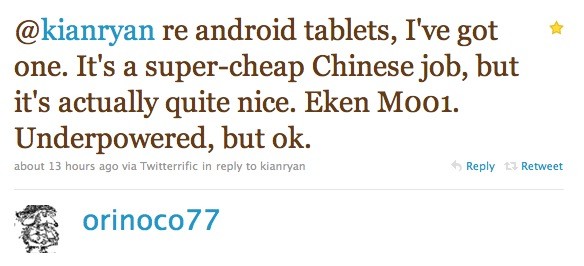This is in response to a twitter post from Dom Hogdeson, in which the Hodge asks:

Well, that’s a very good question Mr Hodge. There’s not much on the market just yet, but let’s see if we can answer that.
Dell Streak
This first tablet from a big name to become available on a network in the UK, the Dell Streak is really a large Android phone. Running 1.6 (slated[1] to move to 2.2 soon-ish), this is still a phone, but capable of being used as a tablet. Dell are certainly marketing it as such, and is now available from O2.
Dell also have plans of releasing bigger versions of the device in the near future to complement the product line.
Motorola Tablet
Motorola have been busy, with a good run of Android handsets over the past year. They’ve hardly been able to keep the Milestone/Droid in stock, partly thanks to an aggressive and quite clever marketing campaign in the US.
At CES 2010, Motorola waved around a 7 inch tablet running Android, with an expected launch date of July. We don’t know a lot, but we do know it’s running a NVidia chipset, probably Tegra 2.
Samsung Galaxy Tab
Described as a “Galaxy S on Steroids”, it’s not far off… The big brother to the Galaxy S, the Galaxy Tab is scheduled for a release in November and (should be) shipping in three sizes (initially 7 inches), so suit all suitcases.
There’s also a promise of a tweak to the UI, on top of TouchWiz to better support the larger format. Not sure where that’s going yet, but I’m quite curious to see.
Notion Ink Adam
The geek in me gets a little wet over this one. The device was waved around at CES last year and promises some goodies that make is stand out from the competitors:
- 1GHz nVidia Tegra 2 Dual-Core A9.
- Dual mode screen – LCD for full functionality and a reflective e-paper mode for reading in sunlight.
- 3 USB ports (USB, not some random dock interface)
- Android by default, support for Chrome OS and Ubuntu.
There’s been quite a lot of hype around this device and expectations are high, it’s very much a toy for the geeks. Plenty of juice, plenty of expansion, and the ability to run multiple OSs on it make it a good choice for the true mobile geek. And the screen is a god-send.
This is the tablet I am waiting for. I will be one of the first in-line when it is finally released.
[Update] – Eken M001
After I made this blog post, Orinoco popped his head up to say:

A quick google shows this to be a WIFI only tablet device running Android 1.6 with a 7″ resistive screen and a 600Mhz processor, but the nice part is the price – $100. Orinoco bought his for £65 from eBay, 1/6th the price of an iPad. It looks great if you use it as nothing more than a mobile web browser.
[Update] – Roll Your Own
One of the niceties about the Android OS is it’s (mostly) Open Source and there’s been a great hacking community built up around it with people porting it to all sorts of unexpected devices, including legacy HTC Windows Mobile devices and even the iPhone.
The Android-x86 project has been working on a version specifically tailored to working on x86 devices making it perfect for existing notebooks and tablet devices. You lose Google Market (only available to official devices and builds) but you can still happily run third party apps through other sources, since you can happily install any .apk that meets the system requirements. It looks like they’re working on 2.1 at the moment, cool times.
The one piece of kit screaming for this attention is The Asus Eee T91, which is supported (alas at the moment with VESA modes). This is a netbook-tablet with a rotating top which allows you to switch between the two modes. Who needs a separate keyboard when you can do that? Yummy.
Everything Else
There’s plenty in the pipeline. Unlike the iOS platform, which needs a dictator to steer the direction – creating the market for new devices as they go, Android devices turn up as the market demands. If people want them, they will be made. A quick search for the word tablet on Phandroid shows plenty of interest from manufacturers. Like Android phones, expect them to start popping up in quite serious numbers shortly towards the end of the year, and some understanding and development of the market (read second generation models) next year.
Of course a device is only as good as the software which runs on top of it. There’s been very little serious interest from Android developers in writing applications for the tablet format yet (well why would you when there are so few out there), but hopefully with a serious crop of tablets turning up in the next 12 to 18 months, that position will change. Unlike the iOS eco-system, there’s not so much fan-fare around device releases, it’s up to individual developers to decide when there’s enough demand in the market for them to port their app to better support the bigger platforms. I personally reckon it’ll take 18 months to 2 years for Android tablets to really take off in a useful way and start upsetting Steve Jobs again.
[1] pun intended.
 There are no ads on this blog and as far as I can remember, never have been.
There are no ads on this blog and as far as I can remember, never have been.